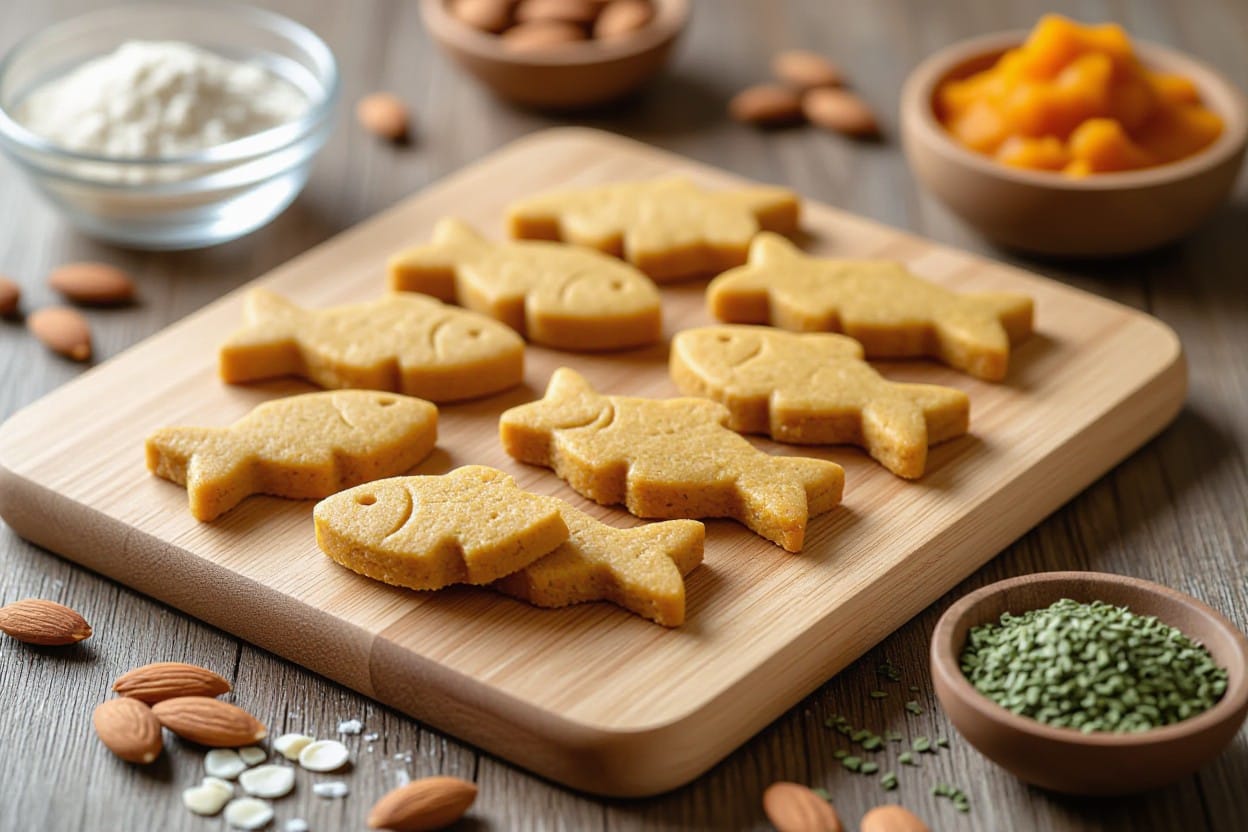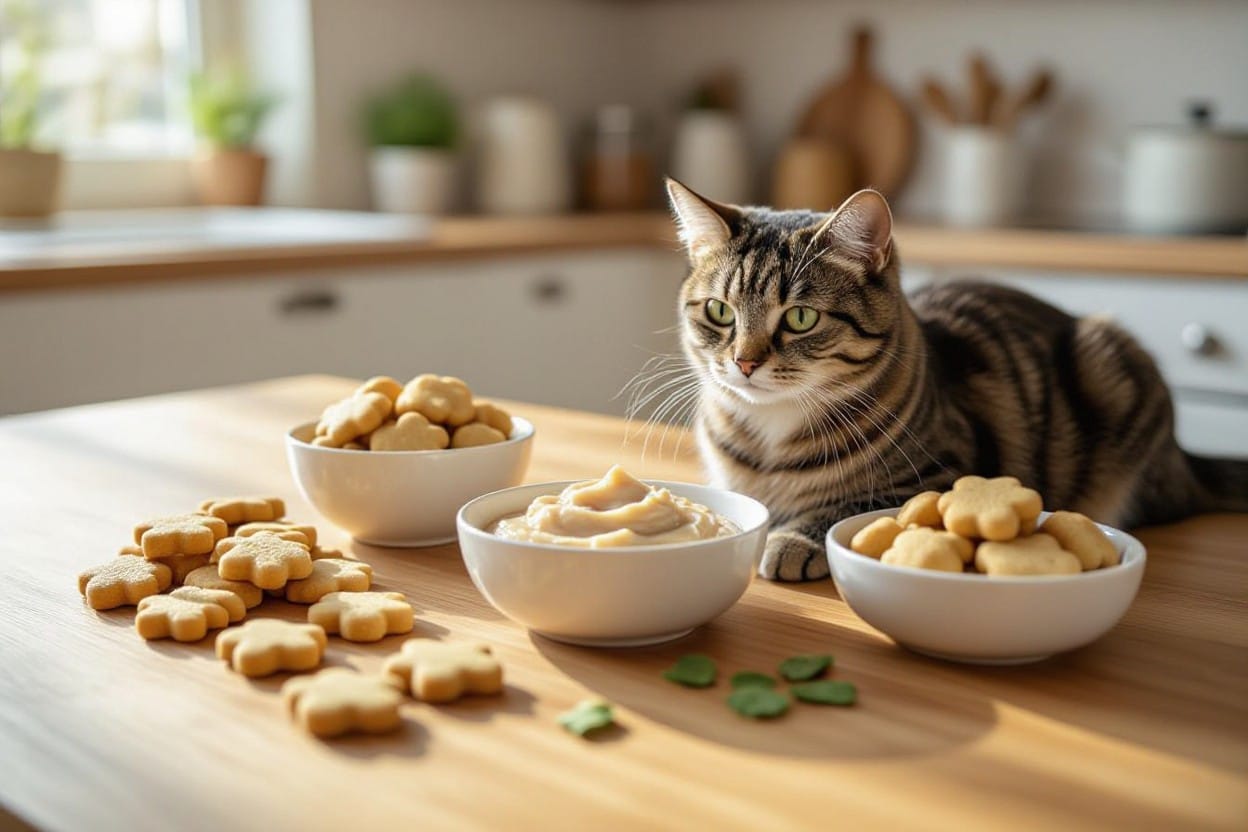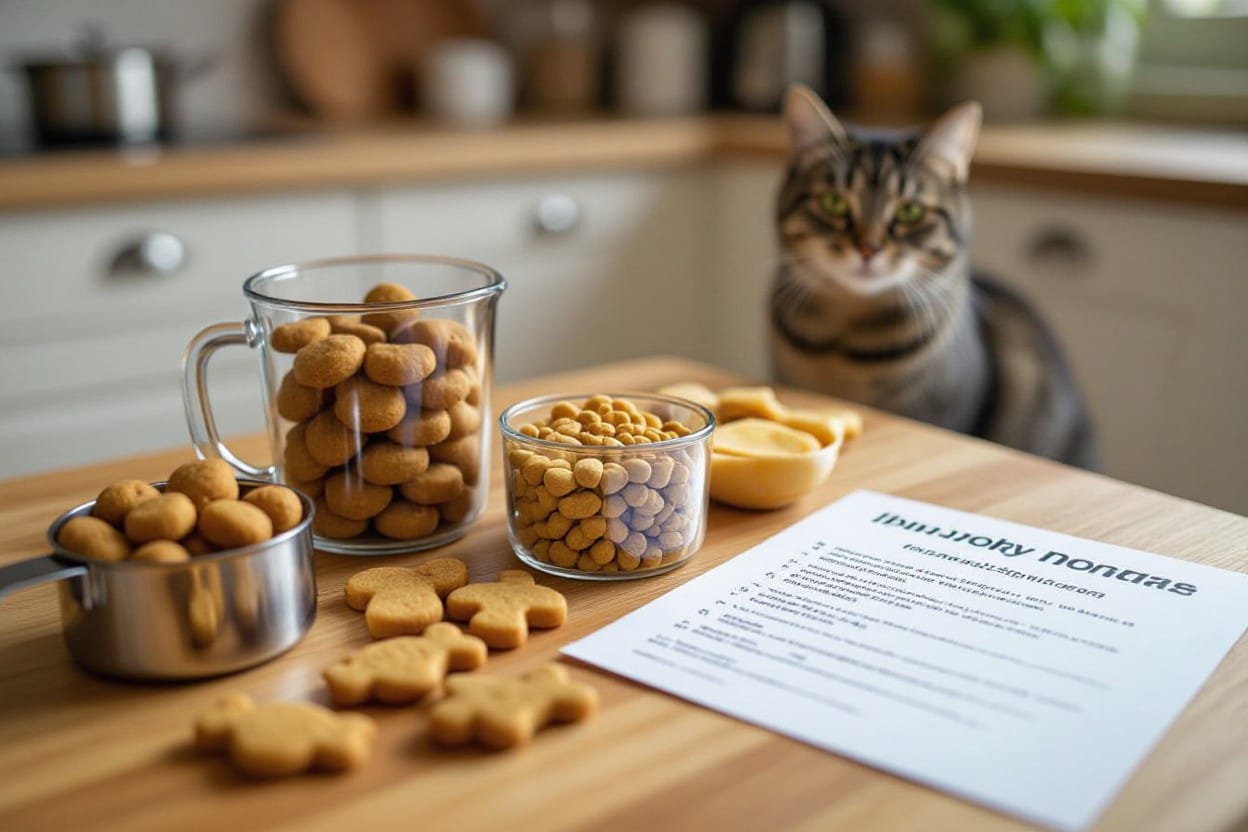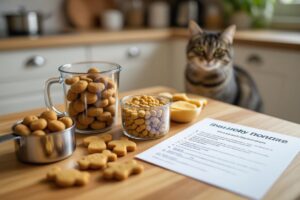Most owners seeking grain free cat treats homemade will find 15 tested recipes and homemade grain free cat treats recipes digestive health tips here to soothe your pet’s sensitivities; you’ll learn how to pick ingredients that avoid common irritants and how to spot toxic foods like onions, garlic, and xylitol that can endanger your cat. This guide provides vet-informed steps to make cat treats for sensitive stomachs that support your cat’s digestion.
Key Takeaways:
- Make grain free cat treats homemade using single-protein sources (chicken, salmon) and simple binders like canned pumpkin to support digestive health cat treats and reduce allergy triggers.
- The 15 recipes are tailored as cat treats for sensitive stomachs, featuring low-fat, low-fiber formulas and options to include probiotics or pumpkin to soothe digestion.
- Use precise measurements and gentle cooking; batch-freeze or refrigerate to preserve freshness — search “homemade grain free cat treats recipes digestive health” for step-by-step recipes and variations.
Understanding Feline Food Sensitivities
Prevalence of Grain Sensitivity in Cats
You may suspect grains are the cause if your cat responds poorly to commercial diets, but research and clinical experience show true grain-specific allergies are relatively uncommon. Studies estimate adverse food reactions affect roughly 1–2% of the general cat population, and most of those reactions are to animal proteins such as beef, fish, chicken or dairy rather than to wheat, corn or rice.
Diagnosing a genuine grain sensitivity requires an elimination trial: a novel-protein or hydrolyzed diet for about 8–12 weeks with no other treats or flavored medications. If you bake grain free cat treats homemade, focus on single-protein recipes and strictly controlled ingredients during the trial to avoid false positives from cross-contamination or hidden additives.
Common Digestive Issues and Symptoms
Chronic or intermittent vomiting and diarrhea are the most frequent digestive complaints you’ll see with food sensitivities, along with soft stools, increased gas and occasional straining. Watch for changes in appetite, weight loss and a dull coat as secondary signs; many cats present with a combination of gastrointestinal and dermatologic symptoms rather than isolated stomach upset.
Immediate reactions (within hours) tend to look like acute vomiting or diarrhea, while delayed hypersensitivities can show up as low-grade chronic signs that wax and wane over weeks. Case reports often describe cats that had persistent soft stool for months that resolved within 4–12 weeks after switching to a novel-protein, grain-free diet.
Have your veterinarian rule out parasites, inflammatory bowel disease and infections before attributing symptoms to food; fecal testing, bloodwork and, when indicated, imaging or biopsy may be necessary. During any dietary trial you run at home, do not give other commercial treats or flavored supplements, since that single slip can mask whether your homemade digestive health cat treats are truly effective.
Benefits of Grain Alternatives in Cat Diets
Replacing grains with digestible alternatives can reduce fermentable carbohydrate load and improve stool quality in some sensitive cats, while allowing you to design cat treats for sensitive stomachs that prioritize single proteins and gentle fibers like canned pumpkin or cooked sweet potato. Grain-free formulations often emphasize higher protein and lower carbohydrate ratios, which better match a cat’s obligate carnivore metabolism.
Homemade grain free cat treats homemade give you precise control over ingredients and preservatives, letting you avoid common protein suspects and additives that commonly trigger reactions. Clinical experience shows many cats show measurable improvement in vomiting frequency and stool consistency within 2–8 weeks of switching to limited-ingredient, grain-free diets or digestive health cat treats.
Practical examples that work well in treats include single-protein sources (turkey, rabbit, venison) combined with safe binders and low-FODMAP fibers like plain pumpkin or mashed sweet potato; keep treats to under 10% of daily calories and use limited-ingredient, novel-protein recipes when conducting an elimination trial. Homemade grain free cat treats recipes digestive health approaches are effective only if you maintain strict ingredient control and monitor response systematically.
Recognizing Digestive Sensitivity in Cats
Physical Symptoms of Sensitivity
Chronic vomiting, loose or watery stools, and recurring constipation are the most common physical signs you’ll see; vomiting more than once a week or diarrhea that persists beyond 48 hours warrants attention. Look for unintended weight loss (even a 5–10% drop in body weight over a month), dehydration, dull coat or excessive shedding, and any traces of blood or mucus in stool—those are danger signs that can indicate severe inflammation or infection.
Onset can be rapid: many cats show GI upset within 3–7 days after a diet change. Vets typically recommend fecal testing and an elimination diet or food trial lasting 6–8 weeks to isolate triggers; during that period you’ll likely switch to a novel protein or a controlled recipe, such as thoughtfully prepared grain free cat treats homemade, to help pinpoint intolerances.
Behavioral Changes Indicating Digestive Issues
Appetite shifts—refusing food one day then begging the next—are common behavioral clues, along with increased vocalization after meals, hiding, or avoiding the litter box. Cats often mask illness, so subtle changes like reduced play, sleeping more, or stopping normal grooming can signal underlying GI discomfort; if your cat loses interest in food or shows post-meal pacing or repeated trips outside the litter box, treat those as meaningful data points.
Some cats develop food aversions tied to episodes of nausea: sudden refusal of a previously liked food or treat can mean that item is associated with discomfort. Notice if your cat excessively licks or chews at the abdomen, brings up hairballs more often, or shows lethargy within hours of eating—those temporal patterns help you link behavior to specific ingredients.
Keep a simple diary recording what your cat eats and the timing and frequency of symptoms for at least 2–4 weeks; you’ll be able to spot correlations between particular commercial treats or ingredients and flare-ups, and homemade recipes for cat treats for sensitive stomachs make it easier for you to remove suspect grains and test one variable at a time.
Common Grain Culprits in Cat Foods
Wheat, corn, and soy are the most frequent grain-based ingredients that contribute to intolerance or poor digestion; other common inclusions are barley, oats, and rice, and you’ll often find derivatives like wheat gluten or soy protein concentrate listed on labels. Many dry formulas allocate roughly 20–50% of the kibble to grain-derived carbohydrates, which can exacerbate loose stools or low-grade inflammation in sensitive cats.
Grains act as inexpensive fillers and binding agents and may provoke either an immune-mediated sensitivity or simple malabsorption—cats have a limited capacity to process high carbohydrate loads compared with omnivores. Switching to a diet that reduces or eliminates these ingredients often produces improvement within 2–4 weeks, especially when paired with controlled, ingredient-transparent options like homemade grain-free snacks.
When evaluating commercial labels, scan the first five ingredients—those provide the bulk of the formula—and watch for ambiguous terms such as “by-products” or “meal” that can hide grain-derived protein sources; using homemade grain free cat treats homemade recipes allows you to avoid these culprits entirely and to manage your cat’s digestive health cat treats one ingredient at a time.
The Role of Alternative Flours
Protein-Based Flours: Benefits and Usage
Protein-based flours such as chicken meal, salmon meal, and dehydrated whitefish concentrate significantly raise the protein density of your treats; chicken meal typically contains around 60–70% crude protein on a dry basis and salmon meal often supplies both protein and beneficial omega‑3s. You can use these flours to achieve the higher protein ratios cats need—aiming for at least 30–40% protein in the finished dry mix for grain free cat treats homemade designed for carnivorous digestive systems.
Use protein flours conservatively as texturizers and nutrient boosters: start by replacing about 10–20% of the dry ingredient weight with a protein flour and evaluate palatability and stool quality. Watch for signs of excess fat or mineral load—fish meals and bone-derived powders can elevate phosphorus and fat, and overuse may trigger GI upset or worsen renal issues in sensitive cats.
Vegetable-Based Flour Options
Vegetable flours like canned pumpkin powder, sweet potato flour, and tapioca starch function primarily as binders and fiber sources in cat treats for sensitive stomachs; pumpkin supplies soluble fiber that helps firm stool, while tapioca and sweet potato add chew and structure without gluten. For digestive health cat treats, incorporate vegetable flours at low levels—typically 5–15% of the dry mix—so you provide fiber without overloading carbs.
Formulation tips: swap 1–2 tablespoons of pumpkin powder per cup of mix to boost soluble fiber, or use 5–10% sweet potato flour to improve texture. Hydration changes when you add starches—expect to increase wet binder (eggs, canned pumpkin) by 10–20% to prevent dry, crumbly treats.
Glycemic impact matters for pets with metabolic concerns; tapioca and sweet potato have higher digestible carbohydrate content than pumpkin, so avoid heavy use of high‑starch flours in diabetic or weight‑sensitive cats. Pre-cooking or pureeing vegetable flours can improve digestibility and reduce the chance of gastric upset.
Choosing the Right Flour for Your Recipes
Match flour choice to your goal: for grain free cat treats homemade aimed at sensitive stomachs prioritize single‑source protein flours for digestibility and palatability, and use pumpkin powder or low‑glycemic vegetable flours to support stool consistency. A practical target mix is roughly 60–75% protein-based ingredient fraction with 5–15% vegetable binder and the remainder from eggs or canned pumpkin for binding and moisture.
Always test new flours in small batches and monitor for adverse reactions; offer 1–2 treats and observe stool and appetite over 48–72 hours before increasing use. If you see loose stool, vomiting, or reduced appetite, reduce or eliminate the new flour and try an alternative protein or binder.
Specific health conditions require tailored choices: for cats with renal or mineral issues, avoid high‑phosphorus fish meals and bone powders and select lower‑mineral, highly digestible protein sources instead; for allergic cats rotate single proteins and use novel protein flours until tolerance is established. Prioritize gradual changes so your homemade grain free cat treats recipes digestive health goals are met without upsetting your cat’s system.
The Importance of a Balanced Diet
Nutritional Requirements for Cats
Cats are obligate carnivores with specific nutrient targets: AAFCO recommends a minimum of about 26% crude protein for adult maintenance and ~30% for growth/gestation in complete diets, plus a minimum fat level (adult ~9%). You must provide crucial amino acids like taurine and arginine; taurine deficiency can lead to blindness and dilated cardiomyopathy, while arginine deficiency can cause rapid hyperammonemia and collapse. Grain free cat treats homemade should be formulated as complements — not replacements — because treats rarely supply balanced amounts of vitamins, minerals, and amino acids on their own.
Fat and moisture also affect digestive comfort: many cats with sensitive GI tracts do better on moderate-fat, low-residue recipes and benefit from higher-moisture feeding patterns. Keep treats to no more than ~10% of daily caloric intake to avoid diluting the balance of your cat’s main diet, and prefer single-source proteins or hydrolyzed options when designing cat treats for sensitive stomachs to limit antigen exposure.
The Role of Protein in Cat Diets
Protein supplies the indispensable amino acids cats need for maintenance, immune function and hepatic gluconeogenesis; cats evolved to obtain a larger share of metabolic energy from protein than omnivores. Using novel or single-source proteins such as rabbit, duck, or salmon in digestive health cat treats often reduces food-reactive vomiting or diarrhea in sensitive cats. Many commercial and homemade meat-based treats are high in protein — some exceeding 40% crude protein on a dry-matter basis — which is beneficial when treats are small and complement a complete diet.
Processing and safety matter: gently cooked or freeze-dried proteins retain digestibility and reduce bacterial risk compared with raw-feeding. Raw poultry and raw pork carry a higher risk of Salmonella and Campylobacter, so choose safe preparation methods and hygiene if you make grain free cat treats homemade. For cats with sensitive stomachs, smaller, frequent, high-quality protein snacks can stabilize digestion more effectively than large, fatty treats.
More info: include taurine-rich organ meats like chicken heart sparingly in recipes if your treats will contribute a meaningful portion of daily intake, since taurine is one of the most limiting nutrients for cats; if treats ever exceed ~10% of calories, consider consulting a veterinary nutritionist or using a taurine supplement to avoid gradual deficiency.
Essential Vitamins and Minerals
Vitamin and mineral balance underpins long-term health: cats require preformed vitamin A (they cannot convert beta-carotene to retinol), dietary vitamin D, B-complex vitamins (including niacin), and trace minerals such as zinc, copper and iron. Calcium-to-phosphorus balance is especially important for bone and metabolic health; aim for a Ca:P ratio near 1:1 to 2:1 in any formulations that add bone or calcium supplements. Over-supplementing single nutrients—most commonly vitamin A via excess liver—can cause toxicity, so portion control matters.
Urinary and metabolic risks intersect with mineral content: magnesium and phosphorus influence struvite and oxalate risk profiles, and sodium/potassium balance affects hydration and kidney health. Meat-based grain free cat treats homemade often provide appropriate trace minerals in small servings, but adding additional supplements or using liver-heavy recipes can disrupt balance for your cat, particularly if they have kidney disease or urinary tract history.
More info: do not include onion, garlic, chives, or other alliums in recipes as they are toxic to cats even in small amounts; avoid indiscriminate bone-meal or mineral powders unless you have calculated their contribution to the overall diet. If you plan treats to be a regular part of feeding rather than occasional rewards, consult a veterinary nutritionist to ensure the treats support rather than undermine your cat’s complete diet.

15 Grain-Free Cat Treat Recipes
Gentle Digestion Recipes
You can rely on simple, low-fat proteins and soluble fiber to soothe sensitive guts: try a batch of Pumpkin & Poached Chicken Bites made with 1 cup shredded poached chicken, 1/4 cup canned plain pumpkin, 1 egg, and 2 tablespoons coconut flour—form into pea-sized morsels and bake at 325°F for 8–10 minutes. Another fail-safe is Bone Broth Salmon Sliders, where you mix 3 oz cooked salmon, 2 tablespoons reduced-sodium bone broth (cooled), and one egg white, then steam or gently bake; the gelatin in bone broth helps coat the gut lining and supports stool consistency for cats with diarrhea or constipation.
Opt for single-source proteins and minimize binders: avoid adding onion, garlic, chocolate, grapes, raisins, and xylitol, as these are toxic to cats. For the best digestive health, rotate between two gentle recipes rather than introducing multiple new ingredients at once; using the keyword “grain free cat treats homemade” in your recipe notes helps you track which blends worked during a 2–3 week observation of stool quality and appetite.
Probiotic Support Recipes
Sprinkle a veterinary-grade probiotic powder over cooled treats to preserve live cultures—for example, add the recommended dose of a cat-formulated probiotic (look for strains like Enterococcus faecium or feline-labeled blends) to Pumpkin & Bone Broth Poppers once they reach room temperature. Cold-mixed recipes such as chilled pureed pumpkin with a pinch of probiotic work well; probiotics are heat-sensitive, so do not add them to hot mixtures or baking will kill the beneficial bacteria.
Freeze-dried probiotic toppers also integrate easily into texture-based treats: crumble one sachet into a bowl of shredded white fish or turkey, then form and chill. Label these as “digestive health cat treats” so you can correlate improvements in stool consistency or reduced vomiting within 7–14 days, and always follow the supplement manufacturer’s dosing guidance for body weight.
Choose probiotics specifically formulated for cats and consult your veterinarian before starting them if your cat is immunocompromised or on antibiotics; probiotics can interact with certain treatments and require proper timing (often given between antibiotic doses) to be effective.
Novel Protein Options
Introduce novel proteins like rabbit, duck, venison, or quail in single-ingredient treats to isolate allergic responses—create simple Dehydrated Rabbit Strips by slicing lean rabbit thinly and dehydrating at 140°F until completely dry (6–10 hours depending on thickness). Novel proteins often reduce allergic reactions: case studies show that cats with beef or chicken sensitivities frequently tolerate rabbit or venison without itching or gastrointestinal upset.
Keep recipes minimal: a two-ingredient jerky (meat + egg white to bind) or freeze-dried single-protein nuggets lets you test tolerance without confounding ingredients. Clearly mark these as “cat treats for sensitive stomachs” and document any skin or stool changes over an 8–12 week elimination trial to evaluate efficacy.
Source novel proteins from reputable suppliers to avoid cross-contamination with common allergens, and rotate only after a veterinarian-guided elimination trial; successful use of novel proteins often produces measurable reductions in itching and vomiting, but improper sourcing or mixed-ingredient commercial meats can mask true sensitivity results.
Exploring Fish Based Treats
Benefits of Fish in Cat Diets
Using fish in your grain free cat treats homemade gives concentrated, highly digestible protein and a natural source of omega‑3 fatty acids (EPA/DHA), which support skin, coat, cognitive function and can reduce inflammatory responses in sensitive pets. Fish also contributes to taurine intake—an imperative amino acid for cats—so recipes that include salmon, whitefish or sardines will generally boost the nutrient density of your cat treats for sensitive stomachs.
Small oily fish such as sardines or anchovies tend to have lower mercury levels and higher omega‑3 content compared with large predatory species like tuna or swordfish, so you should favor those for regular treats. Keep treat calories modest—no more than 10% of your cat’s daily calories—and pair fish with gentle binders such as pumpkin or cooked sweet potato to create digestive health cat treats that add fiber and soothe digestion.
Recipes Featuring Fish
Dehydrated salmon strips, sardine mash bites, and cod‑and‑pumpkin biscuits are best‑selling templates among homemade fish snacks; you can dehydrate thin fillets at about 135–160°F for 2–6 hours or bake small dollops at 200–250°F for 15–30 minutes until firm and dry. Portion size matters: aim for pea‑to‑thumb‑nail sized pieces so a single treat stays well under that 10% calorie cap. Always remove all bones and avoid raw fish with known thiaminase activity—raw smelt, carp and some freshwater species can destroy vitamin B1, causing neurological issues.
If your cat has a sensitive stomach, stick to single‑ingredient fish recipes and introduce new fish slowly over 5–7 days while watching stool quality and appetite. Example recipe: mix 4 oz cooked, flaked salmon with 2 tbsp canned pumpkin, 1 beaten egg and 1 tbsp coconut flour; pipe into tiny rounds and bake at 300°F for 12–18 minutes until set. Freeze extras in single‑serve portions for up to 3 months to preserve freshness and probiotic support if you add a powdered feline probiotic.
Storage, rotation and vet supervision complete your approach to homemade grain free cat treats recipes digestive health: store treats in an airtight container in the fridge for up to 7 days or freeze longer, alternate fish with novel single‑source proteins every few weeks to reduce sensitization risk, and consult your veterinarian if you observe vomiting, diarrhea, or signs of fish allergy—these reactions require prompt attention.
Therapeutic Treats for Cats
The Importance of Gut Health
Gut health directly affects nutrient absorption, immune response, and even behavior; chronic GI signs such as loose stool, vomiting, or reduced appetite can indicate underlying dysbiosis. You should track stool consistency and frequency after switching to grain free cat treats homemade, since even a single ingredient can shift the microbiome—in clinical cases, owners often see measurable improvement within 2–4 weeks of removing common triggers and adding soothing ingredients.
Targeted treats that support the gut act alongside diet changes and probiotics to reduce flare-ups in cat treats for sensitive stomachs programs. Start small—introduce a single new treat ingredient at a time and note any changes; sustained improvement in stool quality or appetite over several weeks is a reliable signal that the treat is supporting digestive health rather than aggravating it. Avoid garlic, onions, chives, grapes, raisins, xylitol, and any added salt or seasonings that can be harmful.
Healing Ingredients in Treat Recipes
Pumpkin (plain canned) provides soluble fiber that normalizes stool—begin with about 1/4–1/2 teaspoon for small cats and up to 1 teaspoon for larger cats per treat batch. Collagen-rich, low-sodium bone broth supplies gelatin and amino acids that soothe the gut lining; use boiled, skimmed broth and never include cooked bones. Slippery elm powder and marshmallow root offer mucilage that coats irritated mucosa; typical additive amounts in treats are measured in 1/16–1/8 teaspoon portions per serving to avoid over-thickening.
Probiotic inclusion can be beneficial: look for feline-formulated supplements or human products known to contain safe strains like Enterococcus faecium or feline-specific blends, and dose according to the product label (many formulas provide 1–5 billion CFU per serving). Choose novel proteins—rabbit, duck, or whitefish—for cat treats for sensitive stomachs when food allergies are suspected, and prefer single-ingredient, low-fat purees or minced meat bases in your homemade grain free cat treats recipes digestive health to minimize antigen exposure.
Be cautious with fiber: too much pumpkin or psyllium can cause constipation rather than relief; balance soluble and insoluble sources and keep treat frequency low (for most cats, treats should remain under 10% of daily calories). If your cat has kidney disease, pancreatitis, or other systemic conditions, tailor protein and electrolyte content accordingly and avoid high-phosphorus or high-sodium broths.

Nutritional Benefits of Grain-Free Treats
Improved Nutrient Absorption
Removing grains from your treats reduces exposure to phytates and other plant-based anti-nutrients that can bind minerals; studies and feed analyses indicate that animal-sourced proteins typically show digestibility rates around 85–95% compared with many plant proteins at 60–75%, so switching to meat-based formulations in your grain free cat treats homemade recipes can boost uptake of amino acids, calcium, iron and zinc.
Designing treats with lower total carbohydrate content—aiming for under 10–15% carbs by weight for treat batches—helps reduce osmotic load in the gut and limits rapid fermentable substrates that can worsen loose stools; that makes these snacks better suited as cat treats for sensitive stomachs in elimination or maintenance plans.
Reduced Inflammation
Cats with food sensitivities often show low-grade intestinal inflammation triggered by common grains or additive proteins, and clinical reports frequently document symptomatic improvement within 2–6 weeks after switching to single-protein, grain-free snacks—owners commonly report a 40–70% reduction in episodes of vomiting, itching or loose stool during that window.
Formulating treats around novel or single animal proteins (turkey, rabbit, salmon) removes many common antigens, and including a controlled source of anti-inflammatory fats such as fish oil supports resolution of inflammatory signaling in the gut lining; keep ingredient lists short and specific to target digestive health cat treats goals.
Run an elimination-style trial for a clear assessment: feed only your grain-free treats and a single protein diet for about 8 weeks, log stool consistency and frequency, then re-challenge one ingredient at a time to identify triggers—this method gives you the most reliable way to confirm reduced inflammation driven by diet.
Enhanced Gut Health Support
Grain-free treats let you add targeted prebiotics and gentle fibers that support feline microbiota—small amounts of pumpkin, MOS or FOS can increase beneficial Bifidobacteria and Lactobacillus populations within 2–4 weeks, improving stool quality and nutrient extraction when used alongside balanced meals.
Including proven probiotic strains tailored for cats (for example, Lactobacillus spp. or Enterococcus faecium) at effective levels (roughly 10^8–10^9 CFU per serving in a treat) can help stabilize microbiome shifts during dietary changes; pick strains with evidence in felines and incorporate them into your homemade grain free cat treats recipes digestive health formulations.
Balance is key: keep fermentable fiber low (around 1–2% of treat weight), ensure treats account for no more than 10% of daily calorie intake, and confirm overall nutrient adequacy—especially taurine—so your grain-free snacks truly support gut health without introducing new deficiencies.
Interactive Tools for Cat Owners
Implementing a Sensitivity Assessment
You can run a formal elimination trial over 8–12 weeks: feed a single-protein base (e.g., turkey or rabbit) and remove all other foods and treats, including commercial and homemade varieties, unless they match the trial protein. Weigh your cat weekly and score stools on a 1–7 scale (1 = hard pellet, 7 = watery) so you have objective baselines; log vomiting episodes as counts per week. Flag weight loss >5% in a month, persistent vomiting, or bloody stools for immediate veterinary review.
Track caloric intake so treats don’t exceed 10% of daily calories (example: a 10 lb cat ~200 kcal/day, so treats <20 kcal). When you reintroduce one ingredient at a time, allow 7–14 days between introductions and watch for return of symptoms within the first 72 hours; repeatable reactions identify suspects. Use this process to test homemade options like “grain free cat treats homemade — single-protein salmon” and compare outcomes to baseline.
Using a Symptom Tracker
Log daily metrics: stool score, number of vomiting events, appetite (full/partial/none), water intake (ml or times), activity level, and visible skin/coat issues. Create entries like “Day 12: stool score 5, 1 vomit after treat, appetite normal” and sum weekly totals; an actionable threshold is >3 vomiting episodes/week or diarrhea lasting >48 hours — these are red flags for a vet consult.
Analyze trends by calculating 7–14 day moving averages and compare before-and-after figures when you switch to new recipes or to “cat treats for sensitive stomachs.” Success looks like vomiting dropping from 4/week to 0–1/week within 4–6 weeks and stool scores moving toward 2–3. Exportable charts or CSVs make it easier to show your veterinarian clear evidence of improvement or relapse.
Attach timestamped photos of stools or skin flare-ups to entries and label each with the exact treat/recipe name and batch date (for example: “homemade grain free cat treats recipes digestive health — salmon batch 2025-06-12, 2 bites at 09:00”). Those images help your vet correlate visual changes with logged metrics and speed diagnosis.
Keeping a Food Diary
Record every intake: brand or recipe name, full ingredient list, serving size, calories, time, and batch number for homemade items. Example entry: “08:00 — 2 turkey bites (12 kcal) [grain free cat treats homemade, batch 23A]; 18:00 — 1/4 cup dry food (80 kcal).” Tally daily calories so treats remain under the 10% rule and note cooking method (baked vs. fried) because fat content can provoke digestive upset.
Cross-reference each diary entry with your symptom tracker to pinpoint correlations — for instance, if diarrhea spikes 24–48 hours after introducing a new protein, that ingredient becomes a prime suspect. One case saw chronic loose stools resolve in 6 weeks after switching exclusively to single-protein rabbit treats and tracking intake closely; bring your compiled diary to the vet to accelerate diagnosis and treatment.
Keep the diary for at least 8–12 weeks to capture delayed reactions and store it in a shareable format (PDF/CSV). Label homemade entries clearly as “grain free cat treats homemade — [recipe name]” so you can quickly trace any adverse event back to a specific recipe or batch during vet consultations.
Planning an Elimination Diet
Understanding the Elimination Diet Process
Run a formal elimination trial for 8–12 weeks using a single-protein, single-carbohydrate base (or a veterinary hydrolyzed diet) and remove all other food, treats, supplements, and flavored products that your cat may ingest. Track daily logs of stool quality, vomiting, itching, and energy levels—use a simple scale (0–3) for stool consistency and note time-of-day of any events so you can correlate them to feedings or treats.
If your cat shows severe signs such as persistent vomiting, difficulty breathing, or collapse, seek emergency care immediately; these are danger signs and not part of a standard dietary reaction. After your cat is symptom-free for at least 2–3 weeks, reintroduce single ingredients one at a time every 10–14 days while observing for immediate (minutes–hours) or delayed (24–72+ hours) reactions, and consult your veterinarian to confirm findings and consider further testing.
Identifying Trigger Foods
Clinical practice and owner reports point to common culprits like beef, dairy, fish, and chicken, with grains (wheat, corn, soy) less frequently implicated but still possible triggers for gastrointestinal upset. Keep a precise treat log listing brand/recipe, quantity, and timing; if symptoms recur within 48–72 hours of introducing an item, flag that ingredient as a suspect and halt it during the next clean period.
Objective diagnostic tools for food reactions are limited—blood tests and intradermal tests often give false positives—so the elimination/rechallenge approach remains the gold standard for identifying food triggers. Use photographic records of skin lesions or stool and timestamped notes to strengthen the case when you review results with your veterinarian.
For cats with multi-ingredient commercial treats, break formulas down to their top proteins and additives; flavors, dairy-based coatings, and gravy packets are common hidden sources of triggers, so you should inspect labels and exclude anything with multiple protein sources during the trial.
Transitioning to Grain-Free Treats
Phase out old treats over a 7–10 day taper: reduce portion of previous treats by ~75% for days 1–3, 50% for days 4–6, and replace fully by day 7–10 with small amounts (1–2 treats/day) of your new grain-free option while monitoring stool and vomiting. Prioritize single-protein homemade grain free cat treats homemade recipes using chicken, turkey, or salmon and bland binders like canned pumpkin to support digestive health.
Expect to see stool consistency and reduced GI upset improve within 7–14 days for many cats after switching, but maintain the elimination protocol if symptoms persist; slow, controlled reintroduction of other foods helps confirm that improvement is due to the grain-free treats rather than other diet changes.
When you test a specific grain-free recipe, give only that treat for several days rather than mixing multiple new items, and document frequency and volume—this controlled approach makes it far easier to trace any adverse reaction back to a single ingredient or preparation method.
Customizing Recipes for Cats’ Needs
Allergen Filtering
Start an elimination trial with your grain free cat treats homemade by offering a single, novel protein source for a minimum of 6–8 weeks—duck, rabbit, or venison work well when chicken or beef are suspected. Watch for changes in vomiting, loose stools, skin itchiness, or excessive grooming; some cats show improvement within 1–3 weeks but full confirmation requires the entire trial period. Avoid feeding any treats or toppers that contain onion, garlic, grapes/raisins, chocolate, or xylitol, since those ingredients are toxic and can produce acute, dangerous signs.
Keep a detailed ingredient diary and reintroduce one removed ingredient at a time for 7–14 days to spot delayed reactions; if your cat flares after reintroduction, note the exact amount and form (cooked vs. raw). Use single-ingredient homemade options—plain cooked turkey, canned white fish (no additives), or pure pumpkin—as baseline test treats; consult your veterinarian for suspected severe reactions such as facial swelling or breathing difficulty, which require immediate care.
Texture Modifications for Treats
If your cat has dental disease, missing teeth, or is very young, convert crunchy bites into softer, moist formats: blend cooked protein with 1–2 tablespoons of plain canned pumpkin or low-sodium chicken broth and set with gelatin (about 1 tablespoon powdered gelatin per 1 cup liquid) for a pate-style treat that’s easy to chew. Dehydrated or oven-dried jerky offers long shelf life but can be too hard for seniors—steaming, slow-baking at low temperature, or briefly soaking dehydrated pieces in warm broth will soften them without adding grain-based fillers.
Kittens require melt-in-the-mouth textures to prevent gagging; pulse small amounts of cooked protein into a paste and pipe tiny dollops onto parchment for quick-bake treats that stay tender. For cats with swallowing or regurgitation tendencies, eliminate large, dry bites entirely and favor spoonable or paste forms that reduce the need for vigorous chewing and lower the chance of aspiration.
Consider using agar-agar as a plant-based alternative to gelatin if you need a vegetarian binder, and always test final texture at room temperature—what feels soft to you can be firm for a cat’s palate. Store moist, soft treats refrigerated for 3–5 days and label portions to avoid accidental overfeeding; dehydrated treats typically keep for several weeks when kept dry.
Portion Control and Serving Sizes
Use calorie guidelines to keep treats from derailing your cat’s weight and digestive balance: most adult indoor cats need roughly 200–250 kcal/day, so limit treats to 10% of daily calories (≈20–25 kcal). For weight-loss plans or cats already overweight, cut treats to 5% or less of daily intake. Measure treats with a kitchen scale or calibrated spoons—many homemade bite-sized treats fall between 5–15 kcal each, so 1–3 small bites per day is often sufficient.
Integrate treats into your cat’s total daily calories by subtracting treat calories from meal portions rather than adding on top; if you give two 10 kcal training treats, reduce your cat’s wet food by ~20 kcal that day. In multi-cat households, maintain strict portioning and use labeled containers or pre-measured portions to prevent free-foraging and inadvertent doubling-up of treats, which commonly leads to obesity and digestive upset.
Weigh individual batch yields after baking or dehydrating to create a simple calorie-per-piece chart for each recipe—record that chart in your recipe notes so you can quickly calculate portions during training or reward sessions. Check with your veterinarian before changing portions for cats on therapeutic diets, since even grain free treats homemade can interfere with prescribed calorie or nutrient targets, and overfeeding treats remains a leading cause of obesity and related health problems.
Engaging with Your Veterinarian
Discussing Dietary Changes
Plan a 7–10 day transition when introducing new grain free cat treats homemade so your cat’s microbiome adapts; start with 25% new treat mixed into the old treat for 2–3 days, then 50% for 2–3 days, then 75% before fully switching. Ask your vet about running a 6–8 week elimination trial if you suspect food sensitivity: document vomiting, stool quality (scale 1–7), and appetite daily to give objective data at the visit.
Bring ingredient labels or recipes for any homemade grain free cat treats recipes digestive health you’re using so the vet can check for hidden hazards and nutrient balance. Point out supplements such as probiotics (e.g., Enterococcus faecium at manufacturer dosing) or added fiber—your vet can advise appropriate strains and dosages and will flag dangerous ingredients like xylitol, onion, garlic, and excessive vitamin D that must be avoided.
Importance of Regular Health Check-ups
Schedule routine exams at least once a year for adult cats and every 6 months for seniors; cats with chronic GI signs often benefit from rechecks every 3 months while you adjust diet or medications. Request baseline diagnostics (CBC, chemistry, T4) and fecal testing so the vet can compare numbers over time and detect trends such as rising liver enzymes or anemia linked to malabsorption.
Weigh your cat at each visit and use a body condition score; a loss of more than 10% body weight within a month or ongoing vomiting/diarrhea beyond 48 hours warrants immediate follow-up and possibly abdominal ultrasound or cPLI testing for pancreatitis. Your vet can correlate clinical signs with lab results to decide whether prescription digestive health cat treats or a therapeutic diet are needed.
Prepare a two-week food diary and bring samples of any homemade treats to appointments—this lets the clinic run ingredient analysis or advise a referral to a veterinary nutritionist if the homemade recipe lacks crucial nutrients like adequate taurine or appropriate calorie density.
Communicating Nutritional Needs
Provide your vet with exact portion sizes and calorie counts for both meals and treats: treats should generally stay under 10% of daily calories. Use the RER formula (RER = 70 × [body weight in kg]^0.75) and multiply by 1.2–1.4 for maintenance to show your vet actual intake — for example, a 4.5 kg adult cat has an RER ≈ 216 kcal and a maintenance need of ≈259–302 kcal/day.
List macronutrient targets and any supplements you add; cats require high-quality protein and adequate taurine (minimums vary by life stage), and your vet can confirm whether your homemade grain free cat treats homemade fit into the overall balance or risk diluting crucial nutrients. Ask about phosphorus and potassium limits if your cat has renal concerns, and about fat levels if pancreatitis has been a problem.
Consider requesting a short referral to a board-certified veterinary nutritionist when you plan to rely heavily on homemade treats or bespoke recipes for sensitive cats; they can produce a balanced formula and provide lab-based feeding plans so your homemade grain free cat treats for sensitive stomachs support long-term health rather than create deficits.

Creating a Safe Treat Environment
Safe Food Storage Practices
Store handcrafted batches in labeled, airtight containers and note the preparation date; for wet or freshly baked grain free cat treats homemade, keep them refrigerated at or below 40°F (4°C) and use within 3–5 days. Dehydrated or baked treats stored at room temperature in a cool, dark pantry will usually stay good for 2–4 weeks, while properly vacuum-sealed and frozen portions can last up to 3 months at 0°F (-18°C). Use BPA-free containers, freezer-safe bags, or vacuum sealers to limit oxidation and rancidity, especially in fish- or oil-based recipes.
Separate raw-protein prep from finished treats to avoid cross-contamination: designate one cutting board and utensils for raw meats and another for cooked treats, and sanitize surfaces with a dilute bleach solution (1 tablespoon bleach per gallon of water) or a pet-safe disinfectant. For added protection against mold and moisture in humid climates, include food-grade desiccant packs or oxygen absorbers in sealed containers and rotate stock so you’re only keeping small batches that match how quickly your cat will consume them.
Understanding Safe Ingredients
Focus recipes on single, easily digestible proteins like cooked turkey, chicken, rabbit, or white fish and combine them with gut-friendly binders such as canned pumpkin or pureed sweet potato—both common in digestive health cat treats for their fiber content and stool-regulating effects. Avoid onions, garlic, chives, grapes, raisins, chocolate, xylitol, and anything with added salt or onion powder; these ingredients are toxic or harmful even in small amounts for cats. Keep carbohydrate substitutes limited and simple to preserve the grain-free intent of your homemade grain free cat treats recipes digestive health approach.
Use liver sparingly: although nutrient-dense, liver can cause hypervitaminosis A if overfed. Aim for liver to constitute no more than 5–10% of the total treat recipe and limit frequency to occasional treats rather than daily servings. For cats with known sensitivities, select novel proteins (duck, venison, rabbit) for elimination trials and avoid multi-ingredient commercial additives that may hide allergens.
Conduct a 7–14 day single-ingredient trial when introducing a new protein or novel recipe: feed only the new treat plus your cat’s regular diet and log any changes in stool, coat, or behavior. If your cat has preexisting conditions or is on medication, check with your veterinarian before adding costly supplements like fish oil or probiotics; some supplements can interact with meds or worsen pancreatitis in high-fat formulas.
Monitoring Treat Quality
Inspect every batch before serving: discard treats that show mold, off-odors, slimy texture, or discoloration. Create a batch log that records recipe, date made, storage method, and expected shelf life so you can quickly identify older packages. For fish-based recipes, thawed portions should be used within 24 hours in the refrigerator to reduce histamine and spoilage risk.
Watch your cat’s response after introducing new grain free cat treats homemade—track frequency and character of stools, appetite changes, vomiting, or lethargy. Acute signs such as repeated vomiting, severe diarrhea, difficulty breathing, or sudden lethargy require immediate veterinary attention; mild, transient loose stools can indicate minor dietary adjustment but should still be noted and correlated with the treat batch and ingredients.
Maintain small batch sizes that match typical consumption—prepare enough for 1–2 weeks for refrigerated treats and up to a month for dry biscuits—so you can identify and eliminate problematic recipes quickly. Store a sample of each batch sealed and dated for at least a week as a control in case you need to compare suspected spoiled treats with a fresh sample for vet evaluation.
Summing up
Upon reflecting, making grain free cat treats homemade gives you control over ingredients and supports your cat’s digestive health. This guide emphasizes cat treats for sensitive stomachs and digestive health cat treats so you can choose single-protein bases, gentle fibers, and minimal additives to reduce reactions while keeping treats palatable.
By using the homemade grain free cat treats recipes digestive health-focused here, you can adapt textures, portion sizes, and ingredients to suit your cat’s tolerances and preferences. With attention to high-quality proteins, simple preparation, and consultation with your veterinarian for persistent issues, you’ll be able to provide safer, more effective treats that support your cat’s overall wellbeing.
FAQ
Q: What are grain-free cat treats and why choose them for sensitive stomachs?
A: Grain-free cat treats are snacks made without wheat, corn, soy or other common grains, typically relying on animal proteins, vegetables and single-source starches. Cats with food sensitivities may tolerate grain free cat treats homemade better because these recipes reduce exposure to common carbohydrate-based irritants and additives. Choosing cat treats for sensitive stomachs and digestive health cat treats can reduce vomiting, gas and loose stools in many cats, though individual responses vary.
Q: Are grain free cat treats homemade safe and nutritionally balanced?
A: Grain free cat treats homemade can be safe when made with high-quality protein, limited fillers, and no toxic ingredients (onion, garlic, chocolate, grapes, xylitol). Treats should not replace a complete diet — limit treats to about 5–10% of daily calories and use recipes designed for feline nutrition or approved by a veterinarian. For cats with complex medical or digestive issues, consult your vet before switching to homemade digestive health cat treats.
Q: Which ingredients soothe sensitive cat stomachs and work well in these recipes?
A: Gentle, easily digested ingredients include cooked lean chicken or turkey, plain canned salmon or whitefish, small amounts of cooked liver, plain pumpkin puree (not spiced pie filling), low-lactose plain yogurt if tolerated, and single-source starches like sweet potato or tapioca. Avoid common allergens and additives; focus on recipes labeled as cat treats for sensitive stomachs and test one ingredient at a time to identify tolerances. Homemade grain free cat treats recipes digestive health should prioritize animal protein and modest fiber to support digestion.
Q: How should I transition my cat to grain-free treats to avoid digestive upset?
A: Introduce grain free cat treats homemade gradually over 7–10 days by mixing small amounts with the current treat or food and increasing the proportion slowly while monitoring stools, appetite and energy. If you see persistent vomiting, diarrhea or lethargy, stop the new treats and consult your veterinarian. Keeping a short log of changes and symptoms can help pinpoint whether a specific ingredient in cat treats for sensitive stomachs is the issue.
Q: Can I make and store the 15 recipes safely, and what are proper feeding and storage guidelines?
A: Most baked or dehydrated grain free cat treats homemade keep in an airtight container in the refrigerator for 5–7 days and freeze well for up to 3 months; label with date and thaw in the fridge before serving. Dehydrated treats last longer at room temperature if fully dried and stored airtight, but for digestive health cat treats refrigeration is safer. Serve small, bite-sized pieces and limit treats to under 10% of daily calories — adjust portion size by cat weight and activity, and consult your vet for personalized feeding amounts.















